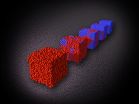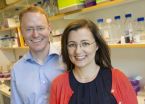(Press-News.org) This news release is available in French.
How many patients receive an incorrect diagnosis of Alzheimer's disease? The answer is a surprisingly high number: over a third! To reduce the number of errors, the diagnostic criteria must be the most reliable possible, especially at the very early stages of the disease. For the last decade, an international team of neurologists, coordinated by Bruno Dubois (Inserm/Pierre and Marie Curie University/AP-HP Joint Research Unit 975) has been working towards this. In the June issue of The Lancet Neurology journal, we see how the researchers have developed a simplified diagnosis based on the most specific criteria of the disease. A challenge primarily for research, but also for clinical practice.
Alzheimer's disease is a neurodegenerative disease. It is the most common (70%) form of dementia. In France, the number of people with Alzheimer's disease and other forms of dementia is estimated at between 750,000 and one million, and is expected to reach 1.29-1.40 million patients by 2030. Alzheimer's disease results from a loss of neurons. The lesions are caused by an accumulation of some brain proteins. The pathology begins with memory problems. This is followed by problems of orientation in space and in time, behavioural problems and loss of autonomy. However, these symptoms are not specific to Alzheimer's disease. The real challenge is to know how to distinguish this disease from other types of dementia, and establish the diagnosis as reliably and as early as possible.
In 2005, an international group of neurologists, coordinated by Bruno Dubois at Inserm, came together to redefine the diagnostic criteria established in 1984. Until then, it had been necessary to await the death of a patient in order to establish a diagnosis of Alzheimer's disease with certainty by examining the lesions in his/her brain. And in the living, only a probability of disease could be inferred, and only at a late stage, based on a certain threshold of severity of dementia.
In 2007, the international team shattered these concepts. The researchers introduced new diagnostic criteria, particularly biomarkers. These are genuine signatures of the disease, and are present from the initial symptoms (prodromal stage).
The publication of these results constituted a revolution. Researchers then observed that with these new criteria, "36% of their patients included in a therapeutic trial based on previous clinical criteria did not have Alzheimer's disease," reports Bruno Dubois. And although this analysis involved only a subgroup of patients, the implications are serious. Patients did not receive the correct treatment and/or care. And flawed patient selection might have had an impact on the lack of efficacy observed for the new treatment.
Since 2007, many studies have been published. And the international group decided to analyse this literature to make the diagnostic algorithm for Alzheimer's disease simpler and more reliable.
"We have reached the end of the road; we have arrived at the essence, something refined, resulting from an international consensus", indicates Prof. Dubois. The diagnosis of Alzheimer's disease will henceforth rely on "just a couple of clinical-biological criteria for all stages of the disease" (see box).
Most of the time, the diagnosis of Alzheimer's disease is based primarily on a suggestive clinical picture. It is subsequently confirmed or rejected using a biomarker.
As regards the clinical picture, there are three scenarios:
typical cases (80-85% of all cases): impairment of episodic long-term memory (known as amnestic syndrome of the hippocampal type and corresponding to difficulty remembering a list a words, even with clues, for example)
atypical cases (15-20% of cases): atrophy of the posterior part of the cerebral cortex or logopenic aphasia (impairment of verbal memory where the patient inverts the syllables of a word when repeating it, for example), or frontal brain damage (which results in behavioural problems)
preclinical states: asymptomatic at-risk (patients without symptoms, but who are fortuitously discovered to have positive biomarkers during scientific studies), and presymptomatic (with a genetic mutation)
One of the following two biomarkers is required:
in the cerebrospinal fluid (obtained by lumbar puncture): abnormal levels of brain proteins (reduced beta amyloid protein and increased tau protein)
in the brain by PET (positron emission tomography) neuroimaging: elevated retention of amyloid tracer
This simpler and more reliable algorithm is important, primarily for research (therapeutic trials, characterisation of the disease, monitoring of patient cohorts, etc.). Outside of research, the use of biomarkers, which is expensive and/or invasive, currently remains limited to young patients or difficult or complex cases in expert centres.
INFORMATION:
Sources
Advancing research diagnostic criteria for Alzheimer's disease: the IWG-2 criteria Bruno Dubois1,2, Howard Feldman3, Claudia Jacova4, Harald Hampel1,2, José Luis Molinuevo5,6, Kaj Blennow7, Steven T DeKosky8, Serge Gauthier9, Dennis Selkoe10, Randall Bateman11, Stefano Cappa12, Sebastian Crutch13,14, Sebastiaan Engelborghs15,16, Giovanni B Frisoni17,18,19, Nick C Fox13, Douglas Galasko20, Marie-Odile Habert21,22, Gregory A Jicha23, Agneta Nordberg24, Florence Pasquier25,26, Gil Rabinovici27, Philippe Robert28, Christopher Rowe29, Stephen Salloway30,
Marie Sarazin31,32, Stéphane Epelbaum1,2, Leonardo C de Souza1,2,33, Bruno Vellas34, Pieter J Visser35, Lon Schneider36, Yaakov Stern37, Philip Scheltens38, Jeffrey L Cummings39
The Lancet Neurology, vol.13, juin 2014
Researcher Contact
Bruno Dubois
UMRS 975 "Research Centre – Brain and Spinal Cord Institute," Inserm, Pierre and Marie Curie University (UPMC), Assistance Publique-Hôpitaux de Paris (AP-HP)
Tel.: +33 (0)1 42 16 75 01
bruno.dubois@psl.aphp.fr
Press Contact
presse@inserm.fr
See our video press release with english subtitles :
http://youtu.be/yNZjw_jictM
Alzheimer's disease: Simplified diagnosis, with more reliable criteria
2014-07-07
ELSE PRESS RELEASES FROM THIS DATE:
R.I. lead law effective, often ignored
2014-07-07
PROVIDENCE, R.I. [Brown University] — When landlords have followed Rhode Island's law requiring them to protect tenants from exposure to lead, their compliance has significantly reduced blood levels of the toxic metal in children. But in four of the state's major cities, only 20 percent of properties that are covered by the law were in compliance with the law even more than four years after it took effect, according to a study by researchers at Brown University, The Providence Plan, HousingWorks RI, and the Rhode Island Department of Health.
"The law works when it is ...
College athletes with abusive coaches more willing to cheat
2014-07-07
WASHINGTON — College athletes who have abusive coaches are more willing to cheat in order to win than players with more ethical coaches, according to new research published by the American Psychological Association and based on surveys from almost 20,000 student athletes at more than 600 colleges across the country.
"Ethical behavior of coaches is always in the spotlight," said lead researcher Mariya Yukhymenko, PhD, a visiting research associate at the University of Illinois at Chicago. "Our study found several negative effects related to abusive coaches, including ...
Penn researchers: Consider the 'anticrystal'
2014-07-07
For the last century, the concept of crystals has been a mainstay of solid-state physics. Crystals are paragons of order; crystalline materials are defined by the repeating patterns their constituent atoms and molecules make.
Now physicists at the University of Pennsylvania and the University of Chicago have evidence that a new concept should undergird our understanding of most materials: the anticrystal, a theoretical solid that is completely disordered.
Their work suggests that, when trying to understand a real material's mechanical properties, scientists would be ...
BGI presents a high-quality gene catalog of human gut microbiome
2014-07-07
July 7, 2014, Shenzhen, China— Researchers from BGI, working within the Metagenomics of the Human Intestinal Tract (MetaHIT) project, and in collaboration with other institutions around the world , have established the highest quality integrated gene set for the human gut microbiome to date- a close-to-complete catalogue of the microbes that reside inside us and massively outnumber our own cells. While the roughly 20,000 genes in the human genome have been available for over a decade, the gene catalog of the microbiome, our much larger "other genome", has to date been much ...
Gene therapy and the regeneration of retinal ganglion cell axons
2014-07-07
Because the adult mammalian central nervous system has only limited intrinsic capacity to regenerate connections after injury, due to factors both intrinsic and extrinsic to the mature neuron, therapies are required to support the survival of injured neurons and to promote the long-distance regrowth of axons back to their original target structures. The retina and optic nerve are part of the CNS and this system is much used in experiments designed to test new ways of promoting regeneration after injury. Testing of therapies designed to improve RGCs viability also has direct ...
Changing Antarctic winds create new sea level threat
2014-07-07
New research shows projected changes in the winds circling the Antarctic may accelerate global sea level rise significantly more than previously estimated.
Changes to Antarctic winds have already been linked to southern Australia's drying climate but now it appears they may also have a profound impact on warming ocean temperatures under the ice shelves along the coastline of West and East Antarctic.
"When we included projected Antarctic wind shifts in a detailed global ocean model, we found water up to 4°C warmer than current temperatures rose up to meet the base of ...
Visualization of peripheral nerve regeneration
2014-07-07
Researchers at the Institute of Polymer Science and Engineering in Taipei, Taiwan, led by Dr. Hsu have been involved in peripheral nerve regeneration research for more than ten years. Dr. Hsu and her team have focused on development of polymeric nerve conduits to facilitate peripheral nerve regeneration. To better translate the research from animal experiments to human therapies, they have recently paid more attention on clinically available methods to visualize the peripheral nerve regeneration process.
This mini-review in Neural Regeneration Research (Vol. 9, No. 10, ...
China's hidden water footprint
2014-07-07
China's richest provinces have an outsized environmental impact on the country's water-scarce regions, according to new research from the International Institute for Applied Systems Analysis (IIASA) and the University of Maryland.
Many developed regions in China are not only drawing from their own water resources but also contributing to water depletion in other water-scarce regions of the country through imports of food and other water-intensive goods, according to the new study published in the journal Environmental Science & Technology. This has environmental impacts ...
DNA origami nano-tool provides important clue to cancer
2014-07-07
Researchers at Karolinska Institutet in Sweden have headed a study that provides new knowledge about the EphA2 receptor, which is significant in several forms of cancer. This is important knowledge in itself – but just as important is how this study, which is published in the highly respected journal Nature Methods, was conducted. The researchers used the method of DNA origami, in which a DNA molecule is shaped into a nanostructure, and used these structures to test theories about cell signalling.
It was previously known that the EphA2 receptor played a part in several ...
Dental pulp stem cells promote the survival and regeneration of retinal cells after injury
2014-07-07
Researchers at the University of Birmingham, UK, led by Dr. Ben Scheven, Dr. Wendy Leadbeater and Ben Mead have discovered that stem cells isolated from the teeth, termed dental pulp stem cells (DPSC), can protect retinal ganglion cells (RGCs) from death following injury and promote regeneration of their axons along the optic nerve.
RGC loss is the leading cause of blindness and can arise through traumatic injury or degenerative diseases such as glaucoma. Neurotrophic factors (NTFs), which travel along the axon of a neuron to a cell body act as survival signals however, ...


